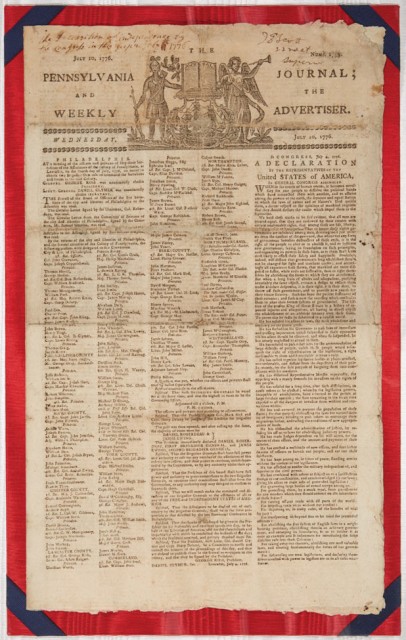“Life, Liberty and the Pursuit of Happiness”
06/29/2016 Books & Autographs

"In CONGRESS, July 4, 1776. A Declaration by the Representatives of the UNITED STATES of AMERICA, in General Congress Assembled. When in the course of human events, it becomes necessary for one people to dissolve the political bands which have connected them with another, and to assume among the powers of the earth, the separate and equal station to which the laws of nature and of Nature's God entitle them, a decent respect to the opinions of mankind requires that they should declare the causes which impel them to the separation.
We hold these truths to be self-evident, that all men are created equal, that they are endowed by their creator with certain unalienable rights, that among these are life, liberty and the pursuit of happiness."
A rare early printing of the Declaration of Independence that appeared in William Bradford's The Pennsylvania Journal and the Weekly Advertiser on July 10, 1776 will be offered as a highlight of the Fall 2016 season at Doyle. This issue of The Pennsylvania Journal and the Weekly Advertiser, one of the earliest printings of the Declaration of Independence in any form, is possibly the only copy in a private collection, the other eight examples being held by institutions.
The text of the Declaration of Independence was adopted by Congress on July 4, 1776, a Thursday, and a manuscript copy was dashed off to John Dunlap's print shop, where the first broadside edition was produced that very night. The current example is notable as it was published by the Revolutionary printer William Bradford, who during 1774-75 had been the official printer to the Congress gathered at Philadelphia. Bradford, a serious patriot, had been publishing The Pennsylvania Journal since the 1740s and had printed both the skull and crossbones and tombstone motifs into his mastheads to protest the Stamp Act in 1765, and had also printed the now infamous segmented snake "Unite or Die" masthead during much of 1775.
Throughout 1776, as the Congress continued to debate independence in Philadelphia, Bradford switched his masthead from "Unite or Die" to the present masthead, a woodcut vignette featuring a Native American, a winged trumpeter, a sailing vessel, and the "Journal" opened on a stand. This vignette is quite evocative of colonial American life in the 18th century, a century dominated by transatlantic voyages, Indian alliances and wars, and of course a slow but increasingly important stream of reliable news.
At the outbreak of hostilities after July 4, 1776, Bradford joined the Pennsylvania militia at 57 years of age and served throughout much of the war, leaving the publication of his paper to his son, Thomas. William Bradford as patriot printer stands in great contrast to the loyalist printer Benjamin Towne, whose thrice-weekly Pennsylvania Evening Post was the first to publish the text of the Declaration in a newspaper on Saturday, July 6. Throughout the war, Towne's paper would flip loyalties depending on which army possessed Philadelphia, going as far to rename his paper The Royal Pennsylvania Gazette when the British took the city in 1778! (He was eventually arrested for treason and left the newspaper business by 1783).
The July 10, 1776 Declaration of Independence issue of Bradford's Pennsylvania Journal is of the utmost rarity. Nineteen examples of the Saturday, July 6 issue of Towne's Pennsylvania Post are known, with three at auction in the past twenty years. John Dunlap printed the text on Monday, July 8, 1776 in Dunlap's Pennsylvania Packet and The General Advertiser, which is known in twelve copies, with none at auction in the past twenty years. On the same day Bradford's paper was published, July 10, 1776, the text also appeared in Hall & Sellers' Pennsylvania Gazette, which features the arms of proprietor William Penn topped by a British lion in its masthead, a confused symbol of English rule. That paper is known in seventeen copies with none at auction in twenty years. Thus, the July 10 issue of Bradford's The Pennsylvania Journal, known in only eight institutions and this possibly sole privately held example, survives in the least amount of known copies and is exceedingly rare. Besides the examples of Towne's Evening Post that sold recently, the only early Philadelphia newspaper printing sold at auction recently was dated July 13.
Visually, the full-sized Pennsylvania Journal is quite appealing in its presentation of the Declaration in the fourth column below the date of the issue (the text concluding on the first column of the second page). Other news in this issue includes in the second column of the front page a resolution to "march under the command and direction of our Brigadier Generals to the assistance of all or any of the FREE and INDEPENDENT STATES of AMERICA." Also of note are other resolutions of the Congress including the report that "On Monday last the Committee of Safety and the Committee of Inspection went in procession to the State-House, where the Declaration of the Independency of the UNITED STATES of AMERICA was read to a very large number of the inhabitants of this city and country, which was received with general applause and heart-felt satisfaction. And in the evening our late King's coat of arms was brought from the Hall, in the State-House, where the said King's courts were formerly held, and burned amidst the acclamations of a crowd of spectators."
Thus, this issue of the Pennsylvania Journal is a highly desirable and rare item of Americana that delivers not only our country's founding document, but also evokes the tremendous urgency, trepidation and elation felt by those present in Philadelphia during our nation's first days in July, 1776.
Suggested Reading: Clarence S. Brigham, History and Bibliography of American Newspapers, 1690-1820, 1947.